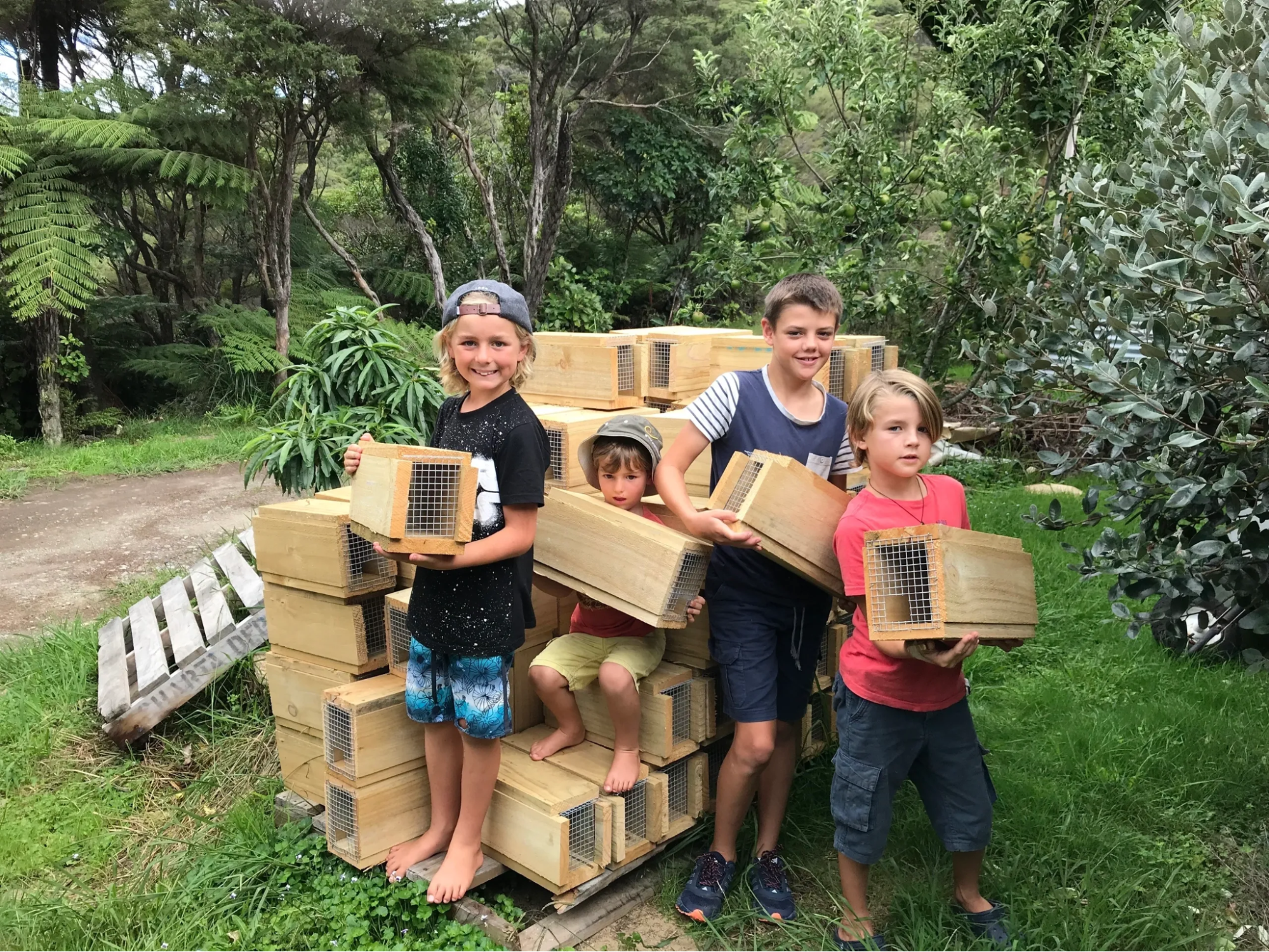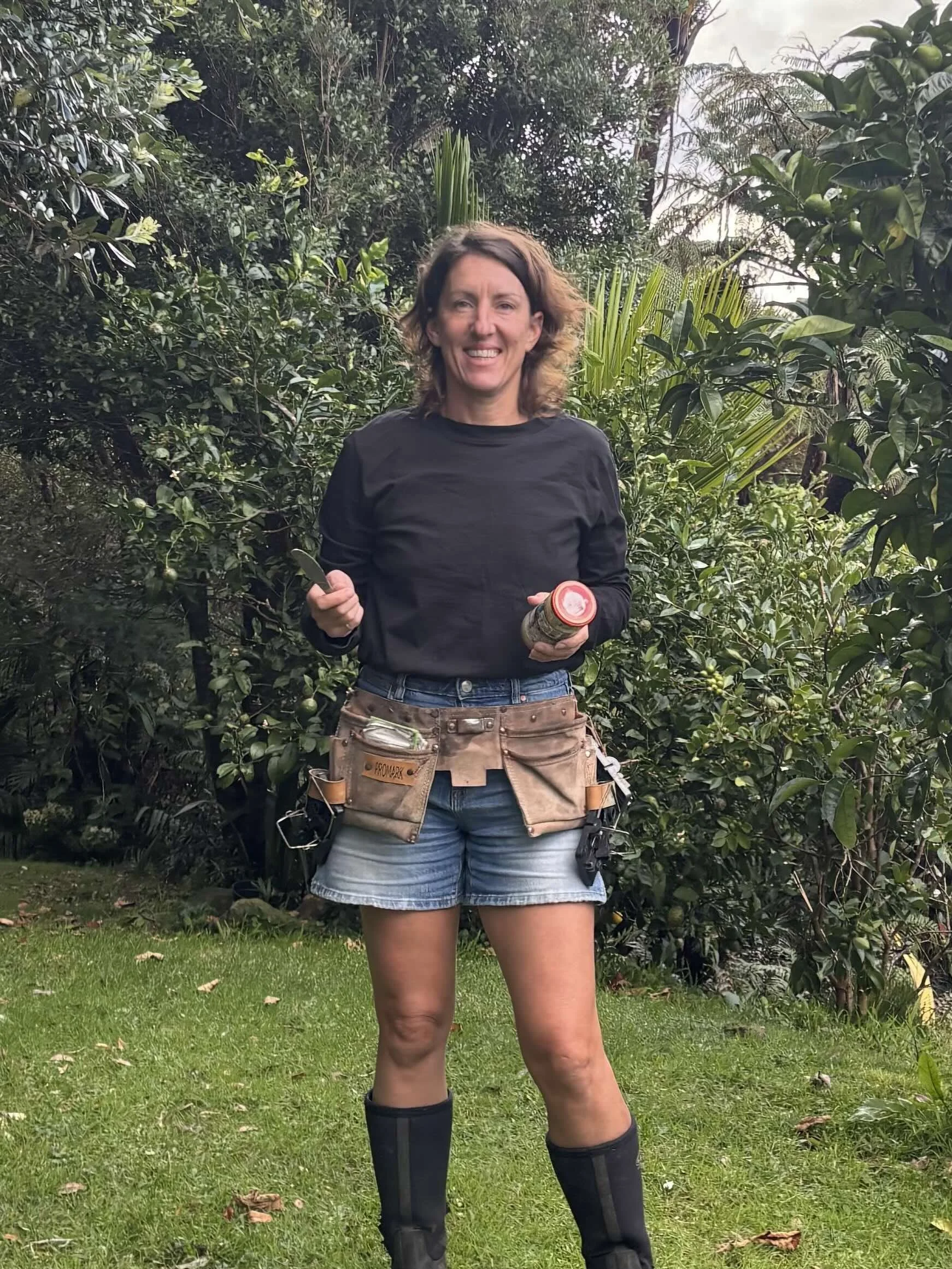Committed Kaitiaki on Hiwitahi
SAM RODNEY-HUDSON (Windy Canyon, Aotea Great Barrier Island)
Sunrise at Hiwitahi
Conservation is a way of life for many people on Aotea Great Barrier Island, and we are no exception. Although this piece of land is rather large, and at times, we wonder what we’ve started, our commitment to ensuring we’re effective and dedicated kaitiaki keeps us going. Standing on the deck we look out to Rakitu, a small island off the east coast of Aotea. Just a stone's throw from Whangapoua Estuary. The bush rapidly falls away below us to the ocean. We are 300m above sea level, so colder than the Aotea valleys by a few degrees and regularly in the clouds. We often think about how little we would know of the comings and goings below the canopy if we hadn’t started pest control on Hiwitahi - the name given to the land before we arrived.
Sam Rodney-Hudson
Hiwitahi is home to three generations: Alison and Brian, their son Nick and myself, along with our two children Zephyr (16) and Ari (11). When we bought the property in 2003, the main attractions were the beaches, local surf break and views of Rakitu and Windy Canyon. For a couple of years, we surfed, and Alison hiked. But we all noticed the lack of birds. The bush was silent, and the forest floor was empty but for leaves. Walking the tracks, inspecting the bush and resetting the traps has become a regular pastime over the last fifteen years. Ari has always loved checking the trap boxes and calling out, “Rat here, Nana” or “No rat.” Their Minecraft gaming name is Aoteatrapper. As the boys have grown up, they have graduated to throwing the rat carcass out and resetting the trap. They wouldn’t say they enjoy that bit, but the tally at the end and the swooping birds are a bonus.
With Alison at the helm, we have been looking after the 90-acre property and making it a safer place for native wildlife. We sit above the Harataonga track, and are surrounded by DOC land and some private properties. It’s steep, full of clay and a few obsidian deposits, and has a history of families working hard on the land. The bush has been regenerating for about 80 years, after being used as pasture. There are pockets of mature native bush with kauri groves, ancient puriri and giant ponga and nīkau. We have a few friends on the mainland who are very excited when they spot mature taraire, toropapa, kauri, rimu, tītoki, tānekaha and puriri, which have survived hundreds of years. These were untouched on account of the steepness of the land, and only the tops were burnt off and turned to pasture. We rely on Stuart Farquhar, local bush legend and serious friend of the Hiwitahi land, to teach us about the significance of our bush. He keeps us motivated to protect the birds by finding new nests and burrows, and enables us to move around the tracks easily with his eye for track flow and maintenance efforts.
From the moment we bought the land, we knew rats were a problem. At first, it was just about keeping them out of the house, but after a while, we started to realise how much these pests were affecting the seedling growth and birdlife. It took a few years, but eventually, we got serious about pest control. Now we have over 250 rat traps and 13 cat traps dispersed throughout the land. In the Autumn months (March to May) we try to check every trap at least fortnightly and every two days around the house. We are an effective lure with nightly catches around our compost bins. This year the trap catches started early, with more than 120 rats cleared from the traps in February. As I write this article March is looking to overtake February, as it often does.



We’ve experimented with all sorts of trap boxes and bait - recycled signboards with wire, plastic, and wooden boxes made by the Aotea Trap Library. We find the Snap-E traps are effective with peanut butter, kindly donated by Pics or Fix and Fogg via the Aotea Environmental Trust. We have been keeping detailed records since 2014. With the help of Dr Grant Dumbell from Aranovus, we have even completed an analysis of the likelihood of our traps being sprung either by a rat triggering the trap and being caught or by something else such as wind, falling debris, or maybe even human error. By recording the percentage of traps that have been sprung and comparing this to the number of days since the traps were set, it has been possible to calculate the daily risk of any trap being sprung, regardless of how it was sprung. This has shown that around 3.6% of traps can be expected to be sprung on the day they are set, with just over 1% being sprung every day after that. There is lots of variation in the data as a result of captures being much more common in summer than in winter, but by checking traps every fortnight then, we should be getting back to every trap before 20% of them have been sprung, This means that on any night of the year, we can expect that at least 80% of our traps are set and ready to catch rats, and we keep increasing the number of traps as Stuart builds more tracks. There’s a good 7 km of tracks winding through the bush. We record all our catches using the TrapNZ website and app.
The effort is paying off. When we first arrived, there wasn't much birdlife—just a pair of territorial kingfishers. Now, tūī, pīwakawaka, and grey warblers are regular visitors, while ruru, kākā, and taiko are breeding nearby. Kererū are also often seen around the house. The most exciting discovery has been the burrows of Tākoketai/black petrel, which we had only heard at night, flying over the house, making their loud clacking noise or calling out from the valley below. Of course, the rats aren’t giving up easily. The new rats still keep moving in, even though some pest eradication efforts are happening on the properties around us, including a significant cat eradication project by Tū Mai Toanga. Stuart has planted hundreds of trees, but what really feels like a win is seeing countless seedlings popping up on their own. The land is also home to an exciting population of chevron and copper skinks, as well as a corridor of glow worms in the damper seasons, first noticed when Ari and I were trapping in the winter and didn’t get home before dark!
Trap records
As mentioned, Stuart Farquhar has been a tremendous help, identifying up to ten burrows and even finding one abandoned petrel egg. In 2024, Jo Sim visited Hiwitahi with her very clever dog Rua, who sniffs out petrel burrows. The pair found numerous burrows of Cooks petrel and the tākoketai and took a photo of a tākoketai chick inside its burrow. Identifying these burrows meant we could intensify cat trapping around these areas. We also set up cameras and were a little shocked by the footage. The camera regularly caught rats, a cat and even a bush rabbit prowling in the area. It also showed the adult tākoketai standing outside its burrow at 1 am, a time when petrels are more active on land.
One of the wildest moments in all our years of trapping was catching an albino ship rat. It had pink eyes, a long tail, and the classic narrow head of a ship rat. Even John Ogden, a retired professor of ecology who’s been on the island for years, had never seen anything like it.



Despite the hard work, there are plenty of rewards. Some nights Alison sits outside listening to the calls of moreporks, black petrels, and kākā. In the spring we are woken in the night by the raucous sounds of many birds. The male kākā, if they don’t find a mate, gather in circles and dance the night away - honestly, it’s like a bird disco out there, a real full moon party. It’s moments like these that remind us why we’re doing this, even if it means broken sleep.
The past year has certainly felt like a supercharged return of birdlife. We think this is not only due to our trapping and planting efforts but also the complete eradication of pests on our dearly loved Rakitu. The battle against the rats isn’t over, but we’re in it for the long haul, as are many in the North of Aotea with trap lines running between houses as part of the Okiwi Ecology project, Glenfern Sanctuary and Tū Mai Toanga. He waka eke noa - we’re in this together. The land is changing, the birds are coming back, and with a bit of luck, and a lot of peanut butter, we’ll keep making a difference.



